Lead Pricing
| Interior | Outside | Balcony | Suite |
|---|---|---|---|
| Request Price | Request Price | Request Price | Request Price |

Quark Expeditions has been one of the leading innovators and operators of expedition cruises, especially in polar regions, since 1991. The company has pioneered and developed a concept of fantastically adventurous journeys in first class comfort on powerful, polar icebreakers. This concept is unique and many “First Ever” passenger voyages have been successfully operated: the first North Pole voyage, the first transpolar voyage through the North Pole, the first Circumnavigation of Antarctica, the first “Far Side” of Antarctica voyage, the first Weddell Sea voyage, the first Northeast Passage and the first Circumnavigation of the Arctic are all part of this tradition.
Names such as Amundsen, Scott, Shackleton, Franklin, Peary and Nansen are synonymous with the Golden Age of Exploration and, thanks to the polar climates, elements of the past have been well preserved. Viewing these historical sights is a great experience and worthy of care and respect. Quark Expeditions understands this and ensures that all our passengers are fully briefed before any visits take place.
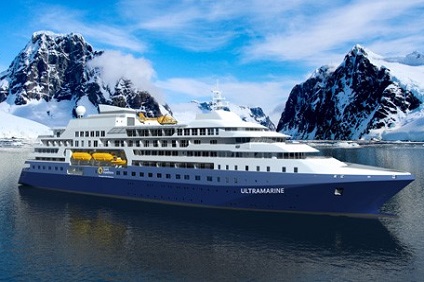
Located on Decks 4 and 6, with approximately 299 sq. ft. (27.8 m2) of indoor living space, and a 70 sq. ft. (6.5 m2) balcony. This suite is perfect for guests wanting a larger living space, full bathroom, and a substantial balcony. Deluxe Balcony Suites are the first suite type to offer additional privacy in the bathroom with an enclosed toilet, a full bath and shower to make it easier for guests to get ready together in the morning.
Features: one double or two single beds, sitting area with sofa bed, private balcony, desk, refrigerator, TV, private bathroom with shower, bathtub and heated floors.
Located on Deck 6, with approximately 350 sq. ft. (32.5 m2) of indoor living space, and a 100 sq. ft. (9.3 m2) balcony. This suite is perfect for guests wanting generous interiors with a wide layout and the largest balconies on the ship. Centrally located on Deck 6, guests will enjoy minimal movement and motion from the comfort of these suites.
Features: one double or two single beds, sitting area with sofa bed, private extra-wide balcony, desk, refrigerator, TV, private bathroom with shower, bathtub and heated floors.

Located on Deck 3, and approximately 285 sq. ft. (26.5 m2). This suite is perfect for guests traveling solo who want to share their experience with other like-minded travelers of the same gender, or for groups of three traveling together. Featuring three separate single beds, and amenities for each of the three guests.
Features: three single beds (two of which can be combined into a double bed), sitting area, picture window, desk, refrigerator, TV, private bathroom with shower and heated floors.
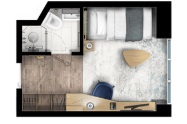
Located on Deck 6, and approximately 132 sq. ft. (12.3 m2). This suite is perfect for solo guests who appreciate privacy and want to wake up to sweeping views from the comfort of their bed. These are the only solo suites with floor-to-ceiling windows available onboard any ship in its class.
Features: single bed, floor-to-ceiling window, desk, refrigerator, TV, private bathroom with shower and heated floors.

Located on Deck 3, and approximately 285 sq. ft. (26.5 m2). These suites are perfect for people traveling together or solo guests looking to share with like-minded individuals. This suite maximizes interior living space while still offering guests the opportunity to stay connected to the outdoors. Our entry-level twin suites are the largest available on a ship of this class.
Features: one double or two single beds, sitting area with sofa bed, picture window, desk, refrigerator, TV, private bathroom with shower and heated floors.

Located on Decks 4 and 6, with approximately 226 sq. ft. (21 m2) of indoor living space, and a 52 sq. ft. (4.8 m2) balcony, this entry-level balcony suite is one of the largest available on a ship of this class. This suite is perfect for guests who are looking for both indoor and outdoor living spaces. There are four connecting suites in this category, making this an excellent option for families or groups wanting to stay connected to each other during their expedition.
Features: one double or two single beds, sitting area with sofa bed, private balcony, desk, refrigerator, TV, private bathroom with shower and heated floors.
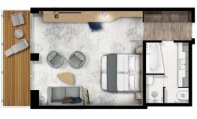
The only suite category to be located on Deck 7, with approximately 369 sq. ft. (34.3 m2) of indoor living space, and a 67 sq. ft. (6.2 m2) balcony. This suite is perfect for guests wanting to wake up to unobstructed polar views from the warmth and comfort of their bed onboard the ship. These suites offer the best of everything—views, spacious interiors, full bathrooms and generous balcony sizes—as well as easy access to the wellness centre.
Features: one double or two single beds, sitting area with sofa bed, private balcony, desk, refrigerator, TV, private bathroom with shower, bathtub and heated floors.
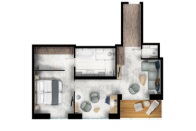
Located on Deck 6, with approximately 446 sq. ft. (41.4 m2) of indoor living space and a 46.3 sq. ft. (4.3 m2) balcony. This suite is perfect for guests who want it all. A large, luxurious suite featuring a private bedroom, full bathroom, powder room, and two separate living spaces. This suite is perfect for families or couples who want all the comforts of home onboard the ship.
Features: one double or two single beds in a private bedroom with walk-in closet, sitting area with sofa bed and additional closet, private balcony, desk, refrigerator, TV, private bathroom with shower, bathtub and heated floors and separate powder room.
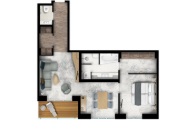
Located on Deck 6, with approximately 563 sq. ft. (52.3m2) of interior living space, and a 46 sq. ft. (4.3 m2) balcony. This suite is perfect for guests who want to travel without compromise. Our largest and most luxurious suite features the most sleeping, entertainment and storage space onboard the ship. It is perfect for families or travelers who want all the comforts of home onboard the ship.
Features: one double or two single beds in a private bedroom with walk-in closet, sitting area with sofa bed and additional walk-in hallway closet, private balcony, desk, refrigerator, TV, private bathroom with shower, bathtub and heated floors and separate powder room.







This ship, whose name means “beyond the sea”, will redefine what is possible in the Polar Regions. This ship will be more than just a ship—it will be an unrivalled home base that allows our guests to experience the Polar Regions in ways never before seen.
Two helicopters and two operable helidecks will allow more of our passengers to simultaneously experience new destinations accessible only by air, and enjoy a once in a lifetime aerial perspective of the Polar Regions.
Ultramarine offers the largest selection of adventure options, including sea kayaking, paddling, camping, mountaineering, skiing, and standup paddle boarding. And now, for the first time ever, the opportunity for flightseeing, helihiking, and heliskiing.
Nature doesn’t wait. Ultramarine’s water-level Zodiac hangar houses 20 Zodiacs launched from four embarkation points easily accessible from two ready rooms. When wildlife has been spotted or a magical sunset appears, passengers won’t miss a thing.
Optimized fuel, water, provisioning, and waste-handling systems have enabled a best-in-class, 70-day operational range that will allow Ultramarine to offer up a completely new set of polar experiences to your clients—from the design of unprecedented new itineraries to exploring new, never-before-seen landing sites.
Ship Profile & Stats
- Length: 128 metres
- Passenger Capacity (dbl): 199
- Ship Registration: Marshall Islands
Ship Facilities
- 4 Bars
- Lift
- Lecture Theatre
- Panorama Lounge & Bar
- Library
- Spa & Sauna
- Fitness Centre
- Bistro Dining Room
- Polar Boutique
- Medical Centre
- 2 Ready Rooms with Individual Lockers
- Main Restaurant

Cruise Itinerary
| Date | Activity | Arrive | Depart |
|---|---|---|---|
| 15 Mar '22 | Buenos Aires, Argentina |
Hotel | |
| 16 Mar '22 | Buenos Aires, Argentina |
Flight to Ushuaia | |
| 16 Mar '22 | Ushuaia, Argentina |
Embark | |
| 17 Mar '22 | Cape Horn (Cruising) |
||
| 18 Mar '22 | Diego Ramirez Islands, Chile |
||
| 19 Mar '22 | Garibaldi Glacier, Chile |
||
| 20 Mar '22 | At sea | ||
| 21 Mar '22 | Chilean Fjords |
||
| 22 Mar '22 | Puerto Natales, Chile |
||
| 23 Mar '22 | Puerto Natales, Chile |
||
| 24 Mar '22 | At sea | ||
| 25 Mar '22 | At sea | ||
| 26 Mar '22 | Ainsworth Bay, Tucker Islet, Chile |
||
| 27 Mar '22 | Brookes Bay, Chile |
||
| 28 Mar '22 | At sea | ||
| 29 Mar '22 | Punta Arenas, Chile |
Disembark | Flight to Santiago |
| 29 Mar '22 | Santiago, Chile |
All itineraries and ports of call at the discretion of the cruise line subject to local weather conditions and may change without notice.
13 Night Cruise sailing from Ushuaia to Punta Arenas aboard Ultramarine. Hotel stay pre-cruise in Buenos Aires.
NOTE: Mandatory Transfer Package/Flights are not included in the fare – this will be at an additional cost. Please check at time of enquiry/booking.
Day 1 Arrive in Buenos Aires, Argentina
You may arrive in Buenos Aires at any time during Day 1 of your itinerary. Upon arriving in this splendid city, known for its architecture and rich European heritage, you will make your own way to your group hotel (pre-expedition hotel night included in mandatory transfer package).
Day 2 Fly to Ushuaia & Embark
After an early breakfast at the hotel, the group will transfer to the airport and board our private charter flight to Ushuaia, Argentina. Upon arrival, you will be transferred from the airport to a central downtown location to have some time on your own to explore this quaint port town before making your way to the pier. After a late afternoon embarkation, you will sail along the historic Beagle Channel, which transects the Tierra del Fuego archipelago in the extreme south of South America.
Day 3 Cape Horn
As we begin our exploration of Chile’s southern extent, expect a new adventure every day. Though each expedition will be different, depending on the weather, we aim to start our journey to the “edge of the earth†with a visit to historic Cape Horn (Cabo de Hornos). At the southernmost point of the Tierra del Fuego (“Land of Fireâ€) archipelago, the most isolated place in the Americas, this steep, rocky headland on Hornos Island marks the northern boundary of the famous Drake Passage, where the Atlantic and Pacific Oceans meet. From the 1700s to the early 1900s, prior to the opening of the Panama Canal, this cape was part of a major global trade route.
If sea and weather conditions allow, you may go ashore for a hike out to the lighthouse, the tiny Stella Maris (“Star of the Seaâ€) Chapel, and the albatross-shaped monument honoring the many mariners who lost their lives attempting to “round the Horn.†Atop the windswept promontory, pause for a moment to take in the panoramic view and to enjoy the peaceful solitude that can only be found at one of the most southern stretches of land in the world. You can even have your passport stamped by the family operating the lighthouse!
Day 4 Diego Ramirez Islands
Your ship will then continue cruising farther south, to the Diego RamÃrez Islands, the most southern point of South America and one of the least-explored places on the planet. This small archipelago was actually thought to be the southernmost land mass in the world when it was discovered in 1619 by the Spanish Garcia de Nodal expedition. Named after the expedition’s cosmographer, the archipelago held this distinction for 156 years, until Capt. James Cook’s discovery of the South Sandwich Islands in 1775. Weather permitting, we’ll Zodiac cruise around these tussock-grass-covered islands to admire the abundant birdlife. A designated Important Bird Area, and part of the recently-designated Diego Ramirez Islands and Drake Passage Marine Park, the archipelago is home to millions of breeding seabirds, and an exceptional place for birdwatching. Binoculars in hand, birders will marvel at the sight of multiple species of albatross (these islands are the southernmost albatross breeding ground in the world), including black-browed albatross, shy albatross and grey-headed albatross. Sightings of dolphins, South American fur seals, and rockhopper, macaroni and Magellanic penguins are also possible here.
Day 5 Pia & Garibaldi Glaciers, Glacier Alley
As our ship sails back north toward the southern edge of Tierra del Fuego, stimulating presentations by your Expedition Team will enrich your knowledge of the glacial systems, geology, environment, wildlife and storied history of the region as you retrace Charles Darwin’s historic journey through the Beagle Channel, a 150-mile (240 km) strait separating Tierra del Fuego’s main island from several smaller islands. Named after Captain Robert FitzRoy’s famous ship on which Charles Darwin was a passenger, the channel presents plenty of photo ops to capture seabirds hovering overhead and dramatic vistas of jagged-peaked mountains and massive tidewater glaciers. Rugged and untouched, this magnificent landscape is as starkly beautiful as it was when Darwin first laid eyes on it in 1833.
Glacier Alley (as it’s nicknamed) is one of the most spectacular ship passages in Tierra del Fuego. To honour the European countries that first explored the region, the glaciers have taken their names—España (Oblicuo), Romanche, Alemania (Roncagli), Francia, Italia, and Holland Glaciers.
Situated within the protected boundary of Alberto de Agostini National Park, both Pia and Garibaldi Glaciers sit at the head of picturesque ice-choked fjords that offer jaw-dropping views. Located within the Cordillera Darwin (Darwin Mountain Range), the impressive Pia Glacier extends from the soaring mountaintops down into the sea. A short hike to a lookout point provides superb vistas of the glacier and mountains.
Surrounded by pristine sub-Antarctic forests, Garibaldi Glacier flows from a separate mountain, providing equally exceptional views, with the Darwin Mountains rising dramatically out of the fjord. We can explore this area by Zodiac, including a beautiful glacial waterfall nearby.
As we navigate the fjords, your Expedition Team will keep watch for Andean condors, massive birds rivaled in wingspan by only the wandering albatross.
Day 6 Dainelli (Aguila) Glacier
Located at the end of a tranquil lagoon surrounded by lush sub-Antarctic forests in Agostini Sound, Dainelli Glacier (sometimes called Aguila—Spanish for “Eagle†Glacier) is a unique sight, as it appears to flow over rolling hills rather than mountains. Cruising aboard a Zodiac toward the blue-tinged wall of ice, conditions permitting, you will be humbled by the wonder of nature’s power. We hope to venture ashore for an easy hike along the beach to get a more intensive look at the glacier and surrounding mountains.
Day 7 Cruising the Chilean Fjords
Continuing north, we’ll navigate through a remote network of coastal fjords and channels, including time spent venturing out into the Pacific Ocean. Your Expedition Team will prepare for the adventures that await, helping you further understand the glacial systems, as well as the flora and fauna that can be found in this part of Chile. Take a moment, as we glide past soaring snow-capped peaks, to contemplate the mariners of long ago who traveled these same sheltered passageways, and were rewarded with the same wondrous sights.
Days 8 and 9 Puerto Natales & Torres Del Paine National Park
Sailing the turquoise waters of the extraordinary stretch of coastline leading to the small port of Puerto Natales, we’ll meander through a mesmerizing maze of deep, windswept fjords, narrow channels and isolated bays, with an eye toward the rugged landscape, unique wildlife and impressive glaciers that tumble from the towering mountains into the icy waters below, along with the imperial and king cormorants, South American terns, black-necked swans and southern wigeons (Chiloé wigeons) that frequent the fjord.
Torres del Paine National Park is one of the most stunning wilderness areas in South America, and Puerto Natales is the gateway. This enormous park is a UNESCO Biosphere Reserve, so designated for both its natural wonders and ancient human history, and named for the three granite peaks that tower above the glacier-fed lakes. Enjoy a full day of hiking tailored to your preferred activity level and stopping at lookouts in the park, followed by a traditional Patagonian barbecue in the afternoon.
Taking our expedition onto dry land for another full day, we will also visit a working Patagonian estancia (“ranchâ€), founded in 1891 by Scottish immigrants. Here you will learn about Patagonian sheep farming in a historic pastoral setting. Inhabiting the surrounding grasslands are the ostrich-like rhea, and guanacos, a wild relative of the domestic llama. Complete your cultural experience with a lunch of barbecued lamb al palo (“on a stickâ€), and return to the ship in the early evening.
Day 10 Canal de las Montañas
Cruising the calm, crystal-clear waters of the Canal de las Montañas (“Channel†or “Fjord of the Mountainsâ€) will leave you breathless. You’ll be awed by the amazing series of waterfalls cascading down between the jagged peaks that rise up sharply on either side of the narrow, 41-mile (66 km) long channel dotted with glaciers, five of which spill dramatically into the water. Here, impressive ice fields glisten, and steeply sloped glaciers exceed elevations over 8,235 feet (2,510 meters). The channel also provides an ideal place to put our Zodiacs in the water for more detailed exploring or going ashore for a hike to scenic viewpoints. If you’re feeling more adventurous, perhaps you’ll treat yourself to an optional kayaking excursion (extra cost), an exceptional opportunity to experience the channel from a special perspective.
Day 11 Tuckers Islets
A series of small islands and rocky outcrops in Almirantazgo Sound (“Admiralty Soundâ€), a small fjord off the Strait of Magellan, Tuckers Islets is a superb location for viewing penguins. Though landing here is prohibited, a Zodiac excursion will take you very near a pebble beach to view a colony of 4,000-plus breeding Magellanic penguins, conditions permitting. Named for Portuguese explorer Ferdinand Magellan, whose crew sighted the charming creatures in 1520 during the first circumnavigation of the globe, the species is native to the region, and the sight of them in their burrows, lounging on the beach or waddling in and out of the water, is one you won’t forget. If we’re fortunate, we may also see Chilean skuas, Magellanic cormorants (rock shags), imperial cormorants (king shags), oystercatchers, kelp geese, or even dolphins.
Day 12 Ainsworth Bay & Islote Albatros
Continuing our exploration of Almirantazgo Sound, we plan to explore ashore at Ainsworth Bay, one of the most picturesque and pristine places in Patagonia. Surrounded by untouched sub-Antarctic forest, this isolated bay is a protected area within the border of Alberto de Agostini National Park. It hosts abundant birdlife, so you’ll want to keep your eyes peeled as we cruise in the Zodiacs. Hiking options will be available for all fitness levels, affording panoramic views of Marinelli Glacier, Marinelli Fjord and the surrounding Darwin mountain range.
In 2003, a small breeding colony of black-browed albatross was documented on Islote Albatros (“Albatross Isletâ€), located in Admiralty Sound. Normally albatross are seabirds, nesting and feeding in coastal waters and open ocean; this the first record of a colony of this species in inland waters, feeding mainly in fjords and channels.
Day 13 Bahia Brookes
Another excellent spot for glacier exploring in Almirantazgo Sound is Bahia Brookes (Brookes Bay), where, conditions permitting, we’ll go ashore by Zodiac. The bay offers ample chances for closer views of a number of waterfalls and glaciers, including the calving North Brookes Glacier, set against the breathtaking backdrop of the towering Darwin mountain range. Amid the serene silence of this icy wonderland, the only sound you may hear is the powerful roar of ice breaking off and crashing into the frigid waters below. This is also a great location for viewing ice fall deposits, which form reconstituted glaciers, and kame (silt and sediment deposits).
Day 14 Marta Island
In the middle of the Strait of Magellan, Marta Island (Isla Marta) is home to abundant birdlife and more than one thousand Patagonian (South American) sea lions. To protect the wildlife, shore landings are not possible here, but we do plan to circumnavigate the island, providing numerous opportunities to observe and photograph the colony from a short distance, in the comfort of a Zodiac. Called lobos marinos (“sea wolvesâ€) by local Chileans, these giant pinnipeds—males can weigh over 700 pounds/320 kg—form quite a noisy group as each sea lion vies for a choice spot of coastline. As you cruise by, sightings of imperial cormorants, skuas, southern gulls, Antarctic pigeons—and if we’re lucky, dolphins—are also possible.
Day 15 Disembark in Punta Arenas & Fly to Santiago, Chile.
After an adventurous two weeks of exploration, you’ll say goodbye to your Expedition Team and disembark in Punta Arenas, to be transferred to the airport for your charter flight to Santiago, where you are welcome to continue on your own travels or connect to your homeward flights.
